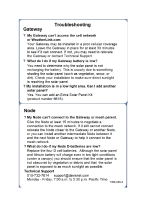
Analog Inputs, Temperature Sensors ....................................................................................................................... 71
Analog Inputs, QT50U Long-Range Ultrasonic Sensor ............................................................................................ 71
Analog Outputs .................................................................................................................................................................71
Analog Outputs, Three-Wire Sensors .......................................................................................................................71
Analog Outputs, Drive Motor Controllers .................................................................................................................. 72
SureCross Power Solutions ...................................................................................................................73
10 to 30V dc Power ........................................................................................................................................................... 73
What is FlexPower®? ........................................................................................................................................................73
Switch Power (with FlexPower) ................................................................................................................................ 74
FlexPower with Integrated Battery ............................................................................................................................74
FlexPower® Solar Supply ........................................................................................................................................ 74
Battery Life Calculations ....................................................................................................................................................75
Analog Configuration ................................................................................................................................................ 75
Discrete Configuration .............................................................................................................................................. 76
Temperature and Humidity Sensor ...........................................................................................................................77
Calculating Battery Life .............................................................................................................................................77
Example Solar Powered Systems ..................................................................................................................................... 78
Parallel Solar Systems ..............................................................................................................................................80
Battery Backup Feature ............................................................................................................................................ 80
Autonomous Process Monitoring with Continuous Sensor Operation ...................................................................... 81
Wireless Network Range Extension ..........................................................................................................................81
Maintenance ............................................................................................................................................ 83
Replacing the Main Body Gasket ...................................................................................................................................... 83
Replacing the Rotary Dial Access Cover ...........................................................................................................................83
Battery Replacement ......................................................................................................................................................... 84
DX81 and DX81H FlexPower Module Battery Replacement ....................................................................................84
DX81P6 FlexPower™ Module Battery Replacement ...............................................................................................84
DX80 Integrated Battery Replacement ..................................................................................................................... 85
DX99 Battery Replacement (DX99...B Housings) .....................................................................................................85
DX99 Battery Replacement (DX99...D Housings) .................................................................................................... 85
Troubleshooting ......................................................................................................................................87
Startup Problems ...............................................................................................................................................................87
LED Message Codes .........................................................................................................................................................87
LCD Message Codes .........................................................................................................................................................89
Modbus Message Codes for Register 8 ....................................................................................................................89
Inputs and Outputs ............................................................................................................................................................ 90
Radio Link Time-Out and Recovery (Non-Host Connected Systems) ...............................................................................91
Accessories .............................................................................................................................................92
Antennas ............................................................................................................................................................................92
DX85 Modbus RTU Remote I/O Devices .......................................................................................................................... 93
FlexPower Supplies and Replacement Batteries ...............................................................................................................93
Other Power Supplies ...............................................................................................................................................94
Sensors ..............................................................................................................................................................................95
Surge Suppressors ............................................................................................................................................................96
Cables ................................................................................................................................................................................96
Antenna Cables ........................................................................................................................................................ 96
Ethernet Cables ........................................................................................................................................................ 97
Adapter Cables ......................................................................................................................................................... 97
Splitter Cables ...........................................................................................................................................................97
Euro-Style Cordsets ..................................................................................................................................................98
Other Cables .............................................................................................................................................................98
Enclosures and Relay Boxes .............................................................................................................................................98
Replacement Parts ............................................................................................................................................................ 99
Radio Certifications .............................................................................................................................. 101
FCC Certification, 900MHz ..............................................................................................................................................101
Contents
4 rev. I






















